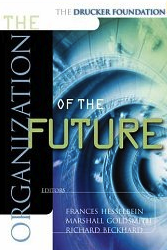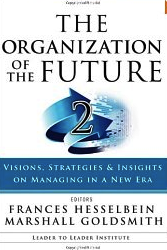Toward new organizations
Authored by Peter F. Drucker. From the introduction to The Organization of the Future published by Peter F. Drucker Foundation for Nonprofit Management (Now the Leader to Leader Institute)
 
The Organization of the Future (The Drucker Foundation)

The Organization of the Future 2: Visions, Strategies, and Insights on Managing in a New Era (J-B Leader to Leader Institute/PF Drucker Foundation)
For over a century, starting in the 1860s, the trend worldwide was toward an employee society of big organizations.
This trend seemed inexorable and irreversible.
The world best-seller in 1965 was a book by a French politician and journalist, Jean-Jacques Servan-Schreiber, titled Le Défi Américain (The American Challenge).
Servan-Schreiber predicted that, by 1990 or so, four-fifths of the world’s manufacturing would be in the hands of, at most, fifteen American multinational companies, each employing hundreds of thousands of people worldwide.
But just when this book had sold millions of copies, the tide turned.
Production and sales in the world economy have more than tripled in these thirty years, but since the mid-sixties, most of the then-existing big businesses—American, British, German, French, Swiss, and even Japanese—have lost market share worldwide.
Adjusted for inflation, few have grown at all, except by merger or acquisition.
One example: in the last ten years, since the mid-eighties, U.S. exports of manufactured goods have almost doubled.
About 80 to 90 percent of that growth has come from small or medium-sized companies.
In fact, where we used to speak of economies of scale, we now increasingly speak of diseconomies of scale.
The trend toward an employee society of big organizations gathered rapid momentum after World War I and, especially, after World War II.
In 1914, before the outbreak of World War I, the great majority of people in the workforce in every developed country were not independent or self-employed.
They were employees as the great majority of workers have been since prehistoric times.
But they did not work for an organization.
They worked for a master or a mistress as hired hands and sharecroppers, as domestic servants, as salespeople in small stores, or as apprentices and journeymen in crafters’ shops.
Only blue-collar workers in manufacturing plants worked for an organization, and they were still a small minority—no more than a tenth of the workforce, even in highly industrialized countries.
By 1965, at least four-fifths of the workforce in the developed world—the United States, Germany, the United Kingdom, and Japan—had become employees of organizations.
In fact, President Lyndon Johnson’s Great Society programs, such as Medicare, assumed that by 1990 or 1995 practically everyone in the U.S. workforce would have become an employee in a big organization (and thus have both employer-paid health insurance and an employer-paid pension).
But just as everyone had accepted this forecast, the tide turned.
The great majority of today’s workforces in highly developed countries do indeed work for or at least with an organization.
But increasingly, they work not as employees of an organization but as temporaries, for an “outsourcing” contractor, as specialists providing expert services, and so on.
We are moving toward a network society rather than an employee society.
For over a century, from their beginnings in the 1860s and 1870s, organizations were based on ownership.
The typical company owned, or at least controlled, whatever it considered its business.
Independent suppliers and distributors existed, but they were “outside.”
The company itself was based on command and control, anchored in ownership.
That is still the structure of traditional businesses, but increasingly, command and control is being replaced by or intermixed with all kinds of relationships: alliances, joint ventures, minority participations, partnerships, know-how, and marketing agreements—all relationships in which no one controls and no one commands.
These relationships have to be based on a common understanding of objectives, policies, and strategies; on teamwork; and on persuasion—or they do no work at all.
And where the old command-and-control organization based on ownership was meant to be permanent, many of the new relationships are temporary and ad hoc.
The multinational business is not, as most people assume, an invention of the post-World War II period.
It goes back to the fifteenth century, to the world’s first financial “superpower,” the Florence based Medici bank.
It was the world’s first true multinational, with sixteen or eighteen branches covering all of Europe.
In both manufacturing and finance and even in retailing, multinationals held a substantially larger share of the world’s business in the decades before the First World War than they do even today.
But multinational meant then, as it did for the Medici, having separate businesses in separate Countries under common ownership.
The Swiss subsidiary of the U.S.-based National Cash Register Company made and sold the same U.S.-designed products as every other National Cash Register subsidiary, but it was run as a Swiss company, was staffed by Swiss nationals (except maybe for an American comptroller), made all its products in Switzerland, and sold them exclusively in Switzerland.
To this day, most British “know” that the Ford Motor Company and the Woolworth Corporation are “true-blue” English companies and that Ivory soap is made by an English company.
But Ford and Woolworth are, of course, wholly owned subsidiaries of U.S. companies, and Ivory soap is made by the wholly owned subsidiary of America’s Procter & Gamble.
But until fairly recently, these subsidiaries were run as autonomous—or at least separate English companies.
Increasingly, companies, even quite small ones, have to be run as “transnational” businesses.
Their market may still be local or regional, but their competition is global.
Their strategy also has to be global, in respect to technology and finance, products and markets, information and people.
This is also true for organizations other than businesses.
The small management school where I teach, for instance, has to base its curriculum on the assumption that it competes not only with management schools in Southern California and the United States but also—in fact, primarily—with management schools in half a dozen European countries and even with management schools in New Zealand.
Increasingly our prosperity, indeed our survival, depends on enrollment from foreign countries, and especially from Asia and Europe, in our Executive Management Program.
And management schools in Switzerland and France are rapidly becoming our most serious competitors in attracting students.
A good many writers, seeing all these changes and all this turmoil, are writing of “the end of organizations.”
That, however, is the one thing we can predict with certainty will not happen.
To be sure, theoretically, anarchy—the absence of organization—is by far the most consistent and most persuasive theory.
The only flaw is that it does not work.
Organizations will be needed even more than before.
Precisely because there will be so much ambiguity, so much flexibility, so many variations, far more clarity will be needed in respect to mission, values, and strategy; in balancing long-range and short-range goals; in defining results.
Above all, absolute clarity will be needed as to who makes ultimate decisions and who is in command in a crisis.
What we mean by organizations is indeed changing.
The first definition of an organization—it might be called the first theory of the organization—comes from the way the Prussian king Frederick the Great, in the mid-eighteenth century, defined his invention of the modern army.
“An army,” he said, “has three parts: infantry walks; cavalry rides; artillery is being pulled.”
An organization, in other words, is defined by how different work is being done.
This basic concept underlay all military organizations through World War II.
But it was also the concept that underlay the first attempt to define business organizations: the theory of the manufacturing business, which was developed around the time of World War I by a French executive, Henri Fayol, the head of what was then Europe’s largest coal mining company.
The purpose of the organization is to get the work done.
This requires a structure that puts similar work, like engineering, manufacturing, and selling, into departments.
After World War I and Alfred Sloan’s reorganization of General Motors Corporation (and culminating in the 1950s with the decentralization of the American General Electric Company), we superimposed on Fayol’s model a structure called the “business unit.”
It tries to balance the internal concern for getting the work done with the external concern of serving the market.
It is still the most widely accepted approach and underlies all of the present discussion of balancing “core competencies” and “market focus” as well as the present concern with reengineering.
But now a totally different approach is emerging, not replacing the older approaches but being superimposed on them: it says that the purpose of organizations is to get results outside, that is, to achieve performance in the market.
The organization is, however, more than a machine, as it is in Fayol’s structure.
It is more than economic, defined by results in the marketplace.
The organization is, above all, social.
It is people.
Its purpose must therefore be to make the strengths of people effective and their weaknesses irrelevant.
In fact, that is the one thing only the organization can do—the one reason why we have it and need to have it.
But as important as these shifts may be in the theory of the organization and the resulting shifts in its structure, even more important is the fact that we are rapidly moving away from the belief that there has to be one theory of the organization and one ideal structure, the belief that underlay Frederick the Great’s definition of an army, Fayol’s “typical manufacturing company,” and the business units of Sloan’s General Motors and Jack Welch’s General Electric.
A good many of the contributors to this volume (The Organization of the Future) still seem to believe that there is—or should be—one ideal organization.
But the very diversity of their contributions makes it clear that organizations will increasingly be fashioned differently: for different purposes, different kinds of work, different people, and different cultures.
The organization is not just a tool.
It bespeaks values.
It bespeaks the personality of a business, a nonprofit enterprise, a government agency.
It is both defined by and defines a specific enterprise’s results.
The most novel fact, and this volume clearly expresses it, is that we are rapidly moving toward a plurality and a pluralism of organizations.
We are rapidly moving toward the new organizations.
|
![]()

![]()